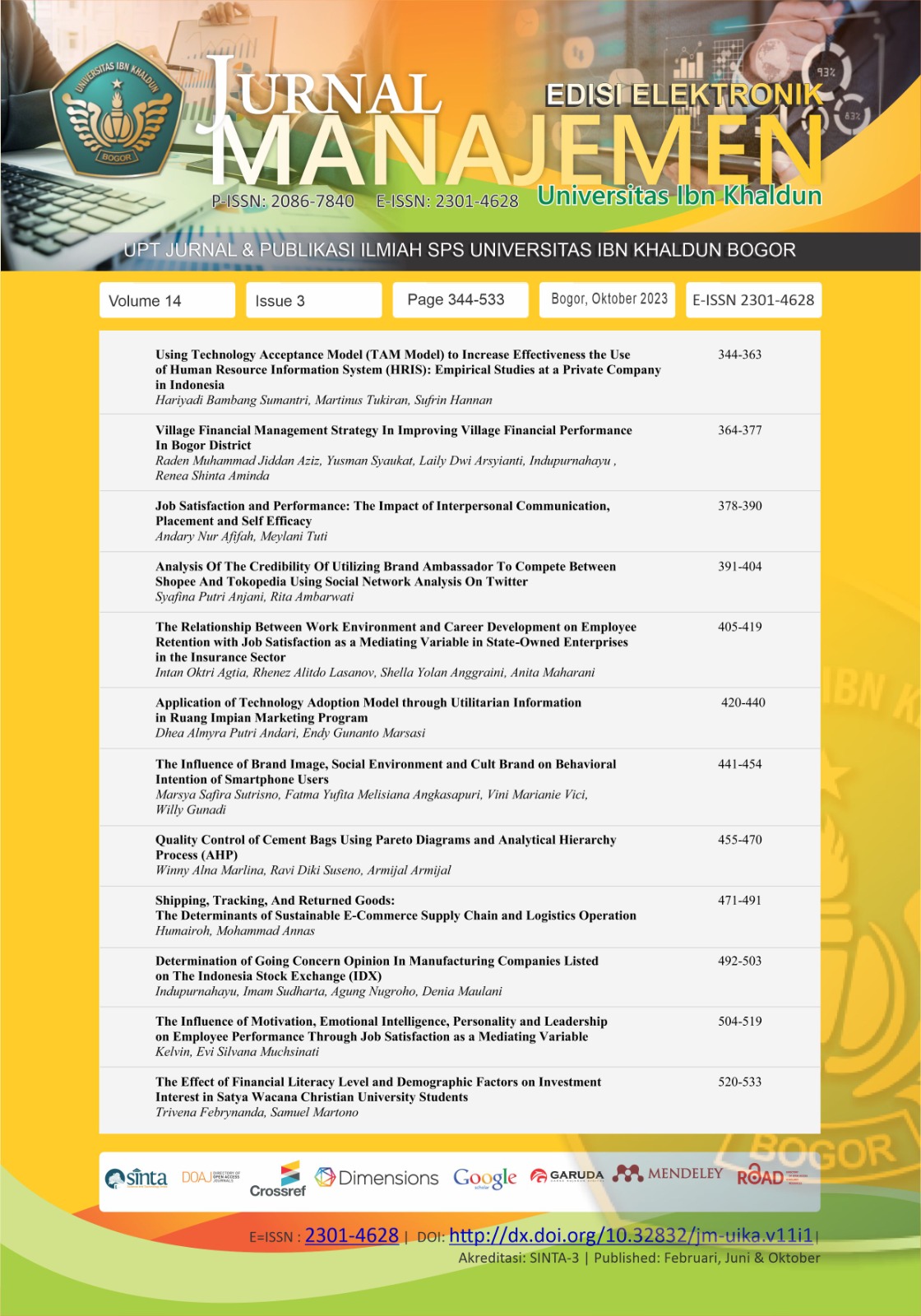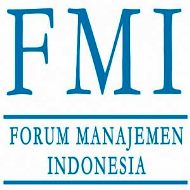The Relationship Between Work Environment and Career Development on Employee Retention with Job Satisfaction as a Mediating Variable in State-Owned Enterprises in the Insurance Sector
DOI:
https://doi.org/10.32832/jm-uika.v14i3.14599Kata Kunci:
Work Environment, Career Development, Job Satisfaction, Employee RetentionAbstrak
There is a possibility of a potential phenomenon that may occur in the next 5 years in the state-owned company in the Insurance and Pension Fund Cluster, which is the occurrence of involuntary employee turnover. This can lead to job vacancies that could be filled by Generation Z. Therefore, it is necessary to anticipate the potential departure of Generation Z in this company. This can pose a challenge to employee retention for the company. To address this, it is important to understand the factors that can influence employees to remain loyal and stay with the company. The implementation of policies in work environment, career development, and job satisfaction ultimately has a positive and significant relationship with employee retention. This study aims to determine the influence of work environment and career development on employee retention mediated by job satisfaction. Work environment and career development are exogenous variables, employee retention is the endogenous variable, and job satisfaction is the mediating variable. The results of hypothesis testing indicate that all tested hypotheses are accepted. The implementation of policies in the work environment, career development, and job satisfaction ultimately has a positive and significant relationship with employee retention.
Referensi
Allen, D. G., Bryant, P. C., & Vardaman, J. M. (2010). Retaining talent: Replacing misconceptions with evidence-based strategies. Academy of Management Perspectives, 24(2), 48–64.
Al-sharafi, H., Hassan, M. E. M., & Alam, S. S. (2018a). The Effect of Training and Career Development on Employees Retention “A Study on the Telecommunication Organizations in Yemen. The Journal of Social Sciences Research, 420–430.
Al-sharafi, H., Hassan, M. E. M., & Alam, S. S. (2018b). The Effect of Training and Career Development on Employees Retention “A Study on the Telecommunication Organizations in Yemen. The Journal of Social Sciences Research, 420–430.
Andriani, T., & Sulistyarini, I. (2022). Can a Supportive Working Environment Retain Millennials Employees on Indonesian SOEs? Asian Journal of Research in Business and Management, 4(2), 24–34.
Aydogdu, S., & Asikgil, B. (2011). An empirical study of the relationship among job satisfaction, organizational commitment and turnover intention. International Review of Management and Marketing, 1(3), 43–53.
Biason, R. S. (2020). The effect of job satisfaction on employee retention. International Journal of Economics, Commerce and Management, 8(3), 405–413.
Bibi, P., Ahmad, A., & Majid, A. H. A. (2018). The impact of training and development and supervisor support on employees retention in academic institutions: The moderating role of work environment. Gadjah Mada International Journal of Business, 20(1), 113–131.
Blau, P. M. (2017). Exchange and Power in Social Life. Routledge. https://doi.org/10.4324/9780203792643
Busro, M. (2018). Teori-teori manajemen sumber daya manusia. Prenada Media.
Champoux, J. E. (2010). Organizational behavior: Integrating individuals, groups, and organizations. Routledge.
Disa, L. Z., & Djastuti, I. (2019). Analisis pengaruh penghargaan dan pengembangan karier terhadap retensi karyawan dengan kepuasan kerja sebagai variabel intervening (Studi pada Karyawan Perum LPPNPI AirNav Indonesia Kota Tangerang). Diponegoro Journal of Management, 81–95.
Ghozali, I., & Latan, H. (2012). Partial least square: Konsep, teknik dan aplikasi SmartPLS 2.0 M3. Semarang: Badan Penerbit Universitas Diponegoro.
Ghuman, U. (2011). Building a model of group emotional intelligence. Team Performance Management: An International Journal, 17(7/8), 418–439.
Hair, J. F., Ringle, C. M., & Sarstedt, M. (2011). PLS-SEM: Indeed a silver bullet. Journal of Marketing Theory and Practice, 19(2), 139–152.
Hamblen, M. (2011). Mobile business 2.0: It’s location, location, location. Retrieved From.
Hausknecht, J. P., Rodda, J., & Howard, M. J. (2009). Targeted employee retention: Performance‐based and job‐related differences in reported reasons for staying. Human Resource Management: Published in Cooperation with the School of Business Administration, The University of Michigan and in Alliance with the Society of Human Resources Management, 48(2), 269–288.
Hayati, N., Yusuf, A. M., & Miharja, R. (2022). The Relationship Between Workload and Career Development on Job Satisfaction; Case Study PT XYZ. HOLISTICA–Journal of Business and Public Administration, 13(1), 125–132.
Herzberg, F. (2017). Motivation to work. Routledge.
Huang, W.-R., & Su, C.-H. (2016). The mediating role of job satisfaction in the relationship between job training satisfaction and turnover intentions. Industrial and Commercial Training, 48(1), 42–52.
Inda, S. S., & Mishra, S. (2016). A study on influence of employee compensation, job satisfaction, working environment on employee retention. International Journal of Multidisciplinary Research and Development, 3(7), 103–116.
Jaskyte, K., Byerly, C., Bryant, A., & Koksarova, J. (2010). Transforming a nonprofit work environment for creativity: an application of concept mapping. Nonprofit Management and Leadership, 21(1), 77–92.
Kim, S. (2012). The impact of human resource management on state government IT employee turnover intentions. Public Personnel Management, 41(2), 257–279.
Koteswari, D. B., Dhanalakashmi, D. R. V, & Tiwari, R. (2020). The role of training and work environment on retention and job satisfaction as a mediator at startups, Bangalore.
Kroon, B., & Freese, C. (2013). Can HR practices retain flexworkers with their agency? International Journal of Manpower, 34(8), 899–917.
Kwenin, D. O. (2013). Relationship Between Work Environment. Career Development Opportunities and Employee Retention in Vodafone Ghana Limited. Global Journal of Human Resource Management, 1(4), 1–9.
Lau, P. L., Chung, Y. B., & Wang, L. (2021). Effects of a career exploration intervention on students’ career maturity and self-concept. Journal of Career Development, 48(4), 311–324.
Lisdiani, V., & Ngatno, N. (2017). Pengaruh pengembangan karir terhadap kepuasan kerja karyawan melalui motivasi kerja sebagai variabel intervening (studi kasus pada Hotel Grasia Semarang). Jurnal Ilmu Administrasi Bisnis, 6(4), 105–112.
Lu, H., Zhao, Y., & While, A. (2019). Job satisfaction among hospital nurses: A literature review. International Journal of Nursing Studies, 94, 21–31.
Ly, P. T. M., Le Tuan Loc, N. T. O., & CongDuc, T. (2020). Role of work environment to job satisfaction: Empirical evidence from Vietnamese state-owned electric enterprise. ICFE 2020, 20.
Mathis, R. L., & Jackson, J. H. (2016). Human Resource Management. Edisi 10 Jilid 3. Jakarta: Salemba Empat.
Mathis, R. L., Jackson, J. H., & Valentine, S. R. (2015). Human resource management: Essential perspectives. Cengage Learning.
Nagarathanam, R., Venkitasamy, S., & Attiah, E. M. (2018). The impact of career development practices on employees’ retention in qatar aviation industry. Proceedings of Ascent International Conference Proceeding.
Nahusona, H. C. F., Rahardjo, M., & Rahardjo, S. T. (2004). Analisis faktor-faktor yang berpengaruh terhadap keinginan karyawan untuk pindah (studi kasus pada PT. Bank Papua). Jurnal Studi Manajemen Organisasi, 1(2), 16–30.
Nanda, A., Soelton, M., Luiza, S., Tama, E., & Saratian, P. (2020). The Effect of Psychological Work Environment and Work Loads on Turnover Interest, Work Stress as an Intervening Variable.
Niati, D. R., Siregar, Z. M. E., & Prayoga, Y. (2021). The effect of training on work performance and career development: the role of motivation as intervening variable. Budapest International Research and Critics Institute (BIRCI-Journal): Humanities and Social Sciences, 4(2), 2385–2393.
Noah, Y., & Steve, M. (2012). Work environment and job attitude among employees in a Nigerian work organization. Journal of Sustainable Society, 1(2), 36–43.
Putra, J. Y. P. (2020). Pengaruh career development dan organizational culture terhadap job satisfaction serta dampaknya pada employee performance. Jurnal Ilmu Manajemen, 8(4), 1185.
RAHAMAN, M. A., UDDIN, M. S., & LATIF, W. Bin. (2023). Effects of Training and Development, Organizational Culture, Job Satisfaction, and Career Development on Employee Retention in Commercial Banks in Bangladesh. The Journal of Asian Finance, Economics and Business (JAFEB), 10(2), 91–97.
Rahman, Y., Ishak, D., Haris, I., Aldi, B. E., & Yuniawati, A. S. (2021). Job discipline, competency, environmental instability, and work effectiveness in gorontalo province on employee quality in tourism industry. Journal of Environmental Management & Tourism, 12(1), 97–106.
Redmond, M. V. (2015). Social Exchange Theory. http://lib.dr.iastate.edu/engl_reports/5
Renaud, S., Morin, L., Saulquin, J.-Y., & Abraham, J. (2015). What are the best HRM practices for retaining experts? A longitudinal study in the Canadian information technology sector. International Journal of Manpower, 36(3), 416–432.
Sekaran, U. (2006). Metodologi penelitian untuk bisnis. Edisi.
Sekaran, U. (2011). Research Methods for Business: Metodologi Penelitian Untuk Bisnis, Buku 1.
Sinaga, O., & Sijabat, R. (2022). Analisis Pengaruh Employee Motivation, Employee Empowerment, Work Life Balance Terhadap Employee Retention Dengan Job Satisfaction Sebagai Variabel Mediasi pada PT XYZ. Jurnal Administrasi Bisnis (JAB), 12(1).
Super, D. E. (1957). The psychology of careers; an introduction to vocational development.
Taheri, R. H., Miah, M. S., & Kamaruzzaman, M. (2020). Impact of working environment on job satisfaction. European Journal of Business and Management Research, 5(6).
Terera, S. R., & Ngirande, H. (2014). The impact of training on employee job satisfaction and retention among administrative staff members: A case of a selected tertiary institution. Journal of Social Sciences, 39(1), 43–50.
Wang, M., & Wanberg, C. R. (2017). 100 years of applied psychology research on individual careers: From career management to retirement. Journal of Applied Psychology, 102(3), 546.
Weng, Q., McElroy, J. C., Morrow, P. C., & Liu, R. (2010). The relationship between career growth and organizational commitment. Journal of Vocational Behavior, 77(3), 391–400.
Yusliza, M. Y., Faezah, J. N., Muhammad, J. S. Z., Ramayah, T., Ali, N., & Noor, N. M. (2021). Analyzing the Relationship Between Supportive Work Environment and Employee Retention. Proceedings of the 11th Annual International Conference on Industrial Engineering and Operations Management.
Unduhan
Diterbitkan
Cara Mengutip
Terbitan
Bagian
Lisensi
Hak Cipta (c) 2023 Jurnal Manajemen (Edisi Elektronik)

Artikel ini berlisensi Creative Commons Attribution-NonCommercial 4.0 International License.
Authors who publish with this journal agree to the following terms:
- Authors retain copyright and grant the journal right of first publication with the work simultaneously licensed under a Creative Commons Attribution-NonCommercial-ShareAlike 4.0 International License that allows others to share the work with an acknowledgement of the work's authorship and initial publication in this journal.
- Authors can enter into separate, additional contractual arrangements for the non-exclusive distribution of the journal's published version of the work (e.g., post it to an institutional repository or publish it in a book), with an acknowledgement of its initial publication in this journal.
- Authors are permitted and encouraged to post their work online (e.g., in institutional repositories or on their website) prior to and during the submission process, as it can lead to productive exchanges, as well as earlier and greater citation of published work (See The Effect of Open Access).











